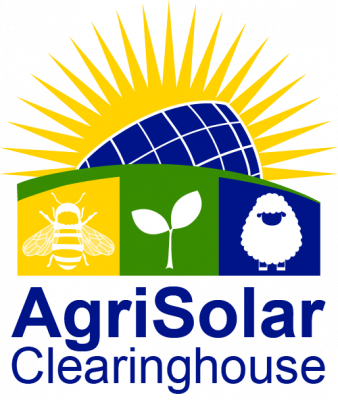This study, performed by a research group that includes AgriSolar Clearinghouse partners Greg-Barron Gafford and Jordan Macknick, describes an integrative approach for the investigation of the co-location of solar photovoltaics and crops, and the potential for co-located agrivoltaic crops in drylands as a solution for the food-energy-water nexus impacts from climate change.
The research focused on three common agricultural species that represent different adaptive niches for dryland environments: chiltepin pepper, jalapeño, and cherry tomato. The researchers created an agrivoltaic system by planting these species under a PV array—3.3m off the ground at the lowest end and at a tilt of 32°—to capture the physical and biological impacts of this approach. Throughout the average three-month summer growing season, researchers monitored incoming light levels, air temperature and relative humidity continuously using sensors mounted 2.5m above the soil surface, and soil surface temperature and moisture at 5-cm depth. Both the traditional planting area (control) and agrivoltaic system received equal irrigation rates, with two irrigation scenarios—daily irrigation and irrigation every 2ays.
The researchers found that shading from the PV panels can provide multiple additive and synergistic benefits, including reduced plant drought stress, greater food production and reduced PV panel heat stress. The agrivoltaic system conditions impacted every aspect of plant activity, though results and significance varied by species. The total fruit production was twice as great under the PV panels of the agrivoltaic system than in the traditional growing environment
Cumulative CO2 uptake was 65% greater in the agrivoltaic installation than in the traditional growing area. Water use efficiency was also 65% greater, indicating that water loss to transpiration was equal between the treatment areas. The increased productivity in the agrivoltaic system is probably due to an alleviation of multiple stress interactions from heat and atmospheric drought.
Because PV panels are sensitive to temperature, the cooling of panels below daytime temperatures of 30 °C positively impacts their efficiency. In this study, researchers found that the PV panels in a traditional ground-mounted array were significantly warmer during the day and experienced greater within-day variation than those over an agrivoltaic understory. Researchers attribute these lower daytime temperatures in the PV panels in the agrivoltaic system to a greater balance of latent heat energy exchange from plant transpiration relative to sensible heat exchange from radiation from bare soil. Across the core growing season, PV panels in an agrivoltaic system were ~8.9+0.2 °C cooler in daylight hours. This reduction in temperature can lead to an increase in PV system performance. Using the system advisor model (SAM) for a traditional and a colocation PV system in Tucson, AZ, researchers calculated that impact from temperature reductions from the agrivoltaic system would lead to a 3% increase in generation over summer months and a 1% increase in generation annually.
These results show the additive benefits of agrivoltaics, to both crop production and energy production, as well as the impacts to ecosystem services such as local climate regulation, water conservation, and drought resiliency.
